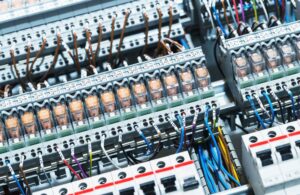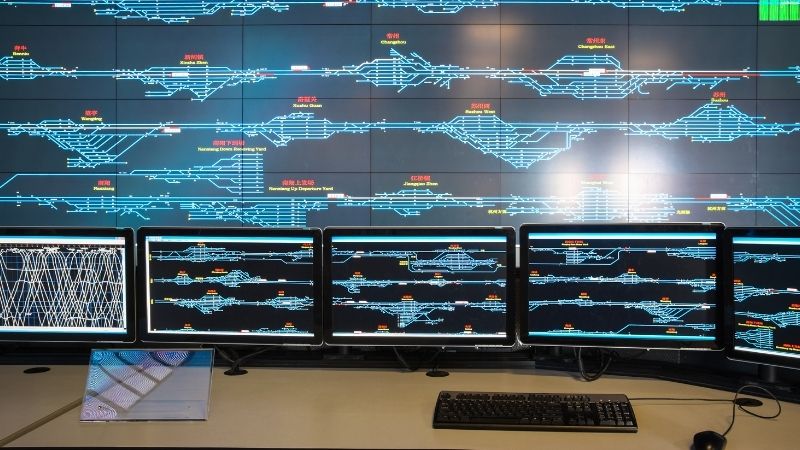HMI vs. SCADA: Alapvető útmutató az ipari automatizáláshoz
Ez a blog belemerül a fő szempontokba HMI és a SCADA rendszereket, azok összetevőit, alkalmazásait és a modern iparágak számára nyújtott előnyöket.
Tartalomjegyzék
Mi az a SCADA és hogyan működik?
A SCADA, a Supervisory Control and Data Acquisition rövidítése, egy központi rendszer, amelyet az ipari folyamatok figyelésére és vezérlésére terveztek. A hardvert és a szoftvert kombinálva a SCADA lehetővé teszi az iparágak számára, hogy valós idejű adatokat gyűjtsenek érzékelők, továbbítsa a vezérlőrendszereknek, és hasznos betekintést nyújtson.
A SCADA rendszerek főbb jellemzői:
- Adatgyűjtés: A SCADA információkat gyűjt az érzékelőktől, és továbbítja egy központi vezérlőközponthoz.
- Monitoring és riasztások: Érzékeli az eltéréseket vagy hibákat, és valós idejű riasztásokat küld.
- Automatizálás: A rendszer automatizálja a rutinfeladatokat, csökkentve a kézi beavatkozás szükségességét.
- Távirányító: A kezelők központi vagy távoli helyről irányíthatják a berendezéseket és folyamatokat.
A SCADA-t kihasználó iparágak:
A SCADA rendszerek különféle ágazatokban találnak alkalmazásokat, többek között:
- Olaj és Gáz
- Vízkezelés
- Gyártás
- Energiaelosztás
- Szállítás
A HMI megértése: A kezelői átjáró
A Human-Machine Interface (HMI) vizuális és interaktív médiumként szolgál a kezelők és az ipari vezérlőrendszerek között. Az érintőképernyőktől a mobileszközökig a HMI-rendszerek lehetővé teszik a kezelők számára a folyamatok zökkenőmentes megfigyelését és vezérlését.
A HMI rendszerek összetevői:
- Hardver: Tartalmazza a beviteli eszközöket (érintőképernyők, gombok) és a kimeneti eszközöket (monitorok, kijelzők).
- Szoftver: Felhasználói felületet biztosít a folyamatok vezérléséhez és az adatok elemzéséhez.
- Kommunikációs protokollok: Lehetővé teszi a gépek és a kezelők közötti adatcserét Modbuson, Ethernet/IP-n vagy vezeték nélküli hálózaton keresztül.
A HMI rendszerek alkalmazásai:
- Gyártósorok felügyelete a gyártásban
- Energiaáramlás szabályozása az intelligens hálózatokban
- HVAC rendszerek kezelése intelligens épületekben
- Szennyvízkezelési folyamatok felügyelete
A HMI és a SCADA kapcsolata
Míg a HMI és a SCADA szorosan összefügg, az ipari automatizálásban eltérő célokat szolgálnak:
- HMI, mint a SCADA összetevője: A HMI felhasználóbarát felületet biztosít a SCADA rendszerrel való interakcióhoz.
- A SCADA mint központi rendszer: A SCADA kezeli és vezérli az összetett műveleteket, míg a HMI a kezelő vizualizációs eszközeként működik.
- Együtt zökkenőmentes adatáramlást, gyakorlati betekintést és hatékony folyamatvezérlést biztosítanak.
A HMI és a SCADA integrálásának előnyei
A HMI és a SCADA integrációja páratlan előnyöket kínál az ipari automatizálás számára:
- Fokozott hatékonyság: Valós idejű megfigyeléssel és adatelemzéssel egyszerűsíti a műveleteket.
- Fokozott biztonság: Figyelmezteti a kezelőket a lehetséges veszélyekre, csökkenti a kockázatokat.
- Költségoptimalizálás: Az automatizálás minimalizálja a működési költségeket és az állásidőt.
- Méretezhetőség: Könnyen adaptálható a bővülő ipari igényekhez.
- Távoli elérhetőség: Lehetővé teszi a kezelők számára, hogy gyakorlatilag bárhonnan felügyeljék a rendszereket.
A SCADA rendszerek alapvető összetevői
A hatékony működés érdekében a SCADA rendszerek négy fő összetevőre támaszkodnak:
- Érzékelők: Mérje meg az olyan paramétereket, mint a hőmérséklet, nyomás és áramlási sebesség.
- Adatkonverziós egységek: Használat PLC-k és RTU-k a nyers érzékelőadatok feldolgozásához.
- HMI irányítópultok: Az adatokat az üzemeltetők számára érthető formátumban mutassa be.
- Kommunikációs hálózatok: Csatlakoztassa az alkatrészeket a létesítményben vezetékes vagy vezeték nélküli módszerekkel.
A HMI és a SCADA jövőbeli trendjei
Az iparágak fejlődésével a HMI és a SCADA rendszerek fejlett technológiákat alkalmaznak a funkcionalitás javítása érdekében:
- IoT integráció: Eszközök csatlakoztatása az intelligensebb adatgyűjtés és -elemzés érdekében.
- AI és gépi tanulás: Prediktív elemzés a karbantartáshoz és a folyamatoptimalizáláshoz.
- Cloud Computing: Központosított adattárolás és távoli elérhetőség.
- Továbbfejlesztett felhasználói felületek: Intuitívabb és testreszabhatóbb HMI-tervek a jobb felhasználói élmény érdekében.
Teljesítse projektjeit vadonatúj, eredeti Omron, Mitsubishi, Schneider HMI-vel – raktáron, készen áll!
Következtetés
A HMI és a SCADA rendszerek az ipari automatizálás nélkülözhetetlen eszközei, amelyek harmonikusan működnek a komplex folyamatok felügyeletében, vezérlésében és optimalizálásában. Míg a SCADA központosított platformot biztosít a műveletek kezeléséhez, a HMI áthidalja a szakadékot a gépek és az emberi kezelők között. Ezek a technológiák együttesen lehetővé teszik az iparágak számára, hogy nagyobb hatékonyságot, biztonságot és termelékenységet érjenek el.
Ha HMI beszállítóra van szüksége, forduljon a Kwocóhoz. Vadonatúj, eredeti HMI-ket kínálunk Proface, Omron, és Mitsubishi, készen áll a világméretű szállításra. Megbízható minőség, megbízható márkák és globális szolgáltatás várja Önt!
Lépjen kapcsolatba velünk
Csak töltse ki nevét, e-mail címét és kérésének rövid leírását ezen az űrlapon. 24 órán belül felvesszük Önnel a kapcsolatot.
Ezeket a témákat is érdekesnek találhatja

A PLC-k megértése: Programozható logikai vezérlők használata
A programozható logikai vezérlők (PLC) a modern ipari automatizálás szerves részévé váltak. Ha valaha is elgondolkozott már azon, hogy az összetett gépek és gyártósorok milyen precíz feladatokat látnak el, a válasz a PLC-k használatában rejlik.

A hat legnépszerűbb Omron PLC beszállító Olaszországban
A hat legjobb Omron PLC beszállító Olaszországban Mint valaki, aki mélyen érintett az ipari automatizálási szektorban, különösen a nemzetközi kereskedelemben

Mi az a PLC, és miért számít ez az Ön vállalkozása számára?
Mi az a PLC, és miért számít ez az Ön vállalkozása számára? Levertnek érzi az ipari automatizálás folyamatos változásait






